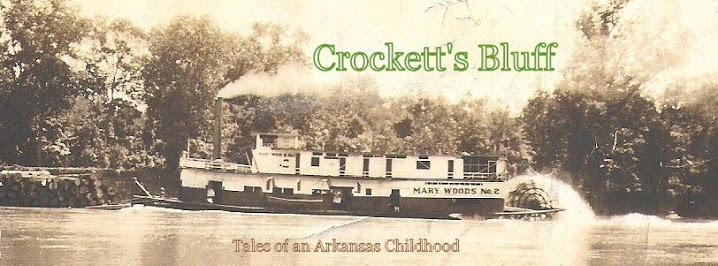Two additional beautifully preserved images that has surfaced and been forwarded to me by Jim Prange, along with some detailed comments posted by John Cover on Facebook. The originals, as Jim notes, were in the possession of a descendant of the Tindall Family and were pass on to him by Glen Mosenthin, the editor of the Grand Prairie Historical Society Journal. "The Prange Bros. referred to here are the four sons of Henry Prange: Theodore, August, Edmund, and George. i would place the photo circa 1915, almost definitely between the years 1908-1923."
.jpg) |
| The Port of Crockett's Bluff: Sunday morning, March 18? 1917
The above image, unlike so many Jim Prange and others have gleaned from their family archives, leaves little mystery, since someone has inscribed the details on the image itself, complete with assurance that the water in the background is the White River: "Prange Bros. and Co. unloading boat load of feed on Sunday morning" followed by the date. It clearly reflects, as he notes, "how busy Crockett's Bluff was at one time."
The image, like so many before it, reveals much about "the port" at the bend of the White River that was gone when those of us who were born and grew up there during the 1940s. The following, passed along by Jim from the archives of the DeWitt Era Enterprise, clearly depicts a relatively thriving, even prosperous community -- essential evidence of the origins of rice farming in Arkansas County.
DEWITT ERA ENTERPRISE - May 20, 1920:
PRANGE BROTHERS HAVE LARGEST RICE FARM - Purchase of Tindall's 2,000 acres give 6,000 acre farm.
"The purchase of A. A. Tindall's 2,000 acre rice farm from which adjoins it's holdings, makes Prange Brothers Company of Crocketts Bluff the owner of the largest rice farm in the state one of the largest in the world. The farm now contains 6,000 acres, 5,000 of which is rice land and the balance timber. The company expects to plant 4,200 acres of rice this season and about 2,000 acres has already been seeded.
There are 18 tenants on the farm, each having charge of from 160 to 400 acres. A single canal system supplies the land with water, which is pumped from White River by two large plants with a total of about 800 horsepower. Two smaller auxiliary pumping plants are located on Sunset Lake. A commissary supplies the tenants and employees; there are huge warehouses for storing grain and a barge line brings in fuel and supplies and delivers the rice to market. Pikes will reach the farm from two directions, when the new system of roads for Arkansas is completed.
Prange Brothers Company, Incorporated, is composed of C. H. Prange [Henry], George and August Prange. The Pranges have been engaged in the rice industry at Crocketts Bluff for a number of years."
These figures fascinate those of us who were born into this community when much or most of this world was gone. Particularly "Pikes will reach the farm from two directions, when the new system of roads for Arkansas is completed." I can only barely remember (I think) when Rt. 153 was graveled. It would not be paved until well into the late 1950s.
Born there in 1935, I can never remember there being any "settlement" of out buildings on the "east" side of the river, so the image surprises. The paddle wheel steam boat is apparently pre-Mary Woods II with no stack of any kind, although it is obviously powerful enough to push a substantial barge of feed (we assume from the inscription). One assumes this was near the bend of the river before the chute for loading grain was built by the Prange Co. The dozen or so flat bed wagons reflect a major operation. If this is feed for livestock in addition to the hay that was bailed, it reflects an operation of impressive size. Of course, those of us who grew up in the 30s-50s would have known little or nothing about horse/mule wagons so prominent here. Those decades just before tractor-driven everything.
When I followed "Old Buck" down George Kline's cotton middles a mile or two west of the Bluff in the late 1940s, followed by Mr. Kline and his favored "Lightning" harnessed before a cultivating plow, we hardly realized we were among the last of a horse-drawn tradition. In springs and summers to follow, however, I would perform similar operations in the driver's seats of seeming endless tractors on Graves, Anderson, Rush, Bullock, Currie, and other farms extending south and west of the Bluff. Although I never became wealthy on my $5.50 per day (sun-up to sun-down) salary (actually $2.50 plowing cotton middles) the work wasn't a complete waste. During a summer between my last high school years I would go to a summer 4H Club "camp" at the University at Fayetteville where I would win the tractor driving contest!
|


























